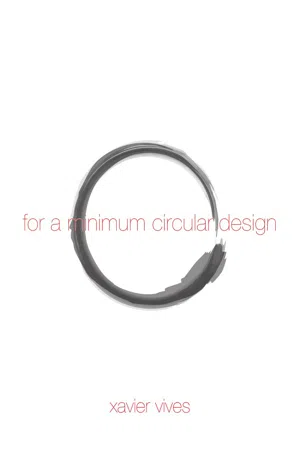
- 350 pages
- English
- ePUB (mobile friendly)
- Available on iOS & Android
eBook - ePub
For a minimum circular design
About this book
Three aspects of the design that are traditionally studied, have been taken: the concept of function associated with that of necessity, the concept of form associated also with the production and the concept of communication and semantics associated with the symbol and the aesthetics. These three concepts have been crossed with the three R's of ecology, that is to say: reduce, reuse and recycle.
Frequently asked questions
Yes, you can cancel anytime from the Subscription tab in your account settings on the Perlego website. Your subscription will stay active until the end of your current billing period. Learn how to cancel your subscription.
At the moment all of our mobile-responsive ePub books are available to download via the app. Most of our PDFs are also available to download and we're working on making the final remaining ones downloadable now. Learn more here.
Perlego offers two plans: Essential and Complete
- Essential is ideal for learners and professionals who enjoy exploring a wide range of subjects. Access the Essential Library with 800,000+ trusted titles and best-sellers across business, personal growth, and the humanities. Includes unlimited reading time and Standard Read Aloud voice.
- Complete: Perfect for advanced learners and researchers needing full, unrestricted access. Unlock 1.4M+ books across hundreds of subjects, including academic and specialized titles. The Complete Plan also includes advanced features like Premium Read Aloud and Research Assistant.
We are an online textbook subscription service, where you can get access to an entire online library for less than the price of a single book per month. With over 1 million books across 1000+ topics, we’ve got you covered! Learn more here.
Look out for the read-aloud symbol on your next book to see if you can listen to it. The read-aloud tool reads text aloud for you, highlighting the text as it is being read. You can pause it, speed it up and slow it down. Learn more here.
Yes! You can use the Perlego app on both iOS or Android devices to read anytime, anywhere — even offline. Perfect for commutes or when you’re on the go.
Please note we cannot support devices running on iOS 13 and Android 7 or earlier. Learn more about using the app.
Please note we cannot support devices running on iOS 13 and Android 7 or earlier. Learn more about using the app.
Yes, you can access For a minimum circular design by Xavier Vives in PDF and/or ePUB format, as well as other popular books in Architecture & Architecture Design. We have over one million books available in our catalogue for you to explore.
Information
Topic
ArchitectureSubtopic
Architecture DesignTable of contents
- Justification and intentions
- 1. Introduction
- 1.1. The person and the object
- 1.1.1. The property and responsibility
- 1.1.2. Beyond design
- 1.1.3. The product
- 1.2. Of simplicity
- 2. Of the need and the function
- 2.1 The needs
- 2.1.1. Desires, wants and needs
- 2.1.2. Luxury
- 2.1.3. Doing without the object
- 2.2. Reducing functions
- 2.2.1. Functional simplicity
- 2.2.2. Eliminating needs
- 2.2.3. Ab initio. Starting from scratch
- 2.2.4. Automating and transferring functions
- 2.2.5. Including and integrating functions
- 2.2.6. Reducing consumables
- 2.3. Reusing functions
- 2.3.1. Functional flexibility
- 2.3.2. Extending functions
- 2.3.3. Modular / standardizing
- 2.3.4. Design for all
- 2.3.5. The anaesthetic object
- 2.4. Recycling functions
- 2.4.1. Rethinking functions
- 3. Of morphology
- 3.1. The shape
- 3.1.1. Shape as a diagram of forces
- 3.1.2. The objective shape
- 3.1.3. Shape – process – material – function
- 3.2. Reducing the shape
- 3.2.1. Structural simplicity
- 3.2.2. The fading of the object
- 3.2.3. Miniaturising
- 3.2.4. Integration
- 3.2.5. Lightening
- 3.2.6. Dematerializing space
- 3.3. Reusing the form
- 3.3.1. Harmonic obsolescence
- 3.3.2. Designing to maintain
- 3.3.3. Standardising / modulating
- 3.3.4. Designing for dismantling
- 3.4. Recycling the form
- 3.4.1. Designing for adaptation
- 3.4.2. Designing for decomposition
- 4. Of the symbol and aesthetics
- 4.1. Aesthetics
- 4.1.1. The phases of aesthetics
- 4.1.2. Kitsch
- 4.1.3. Concinnity and coherence
- 4.2. Reducing the aesthetics
- 4.2.1. Visual simplicity
- 4.2.2. «Less is more»
- 4.2.3. Transparency
- 4.2.4. The aesthetics of lightness
- 4.2.5. From the aesthetics of movement to the aesthetics of excitement
- 4.3. Reusing the aesthetics
- 4.3.1. Styling and fashion
- 4.3.2. The ornament
- 4.3.3. The seductive object
- 4.3.4. The other senses
- 4.4. Recycling aesthetics
- 4.4.1. Semantic changes
- 4.4.2. The recuperation of the lofts
- 4.4.3. The readymade
- 5. Of complexity
- 5.1. Oversimplifying
- 5.2. Praising complexity